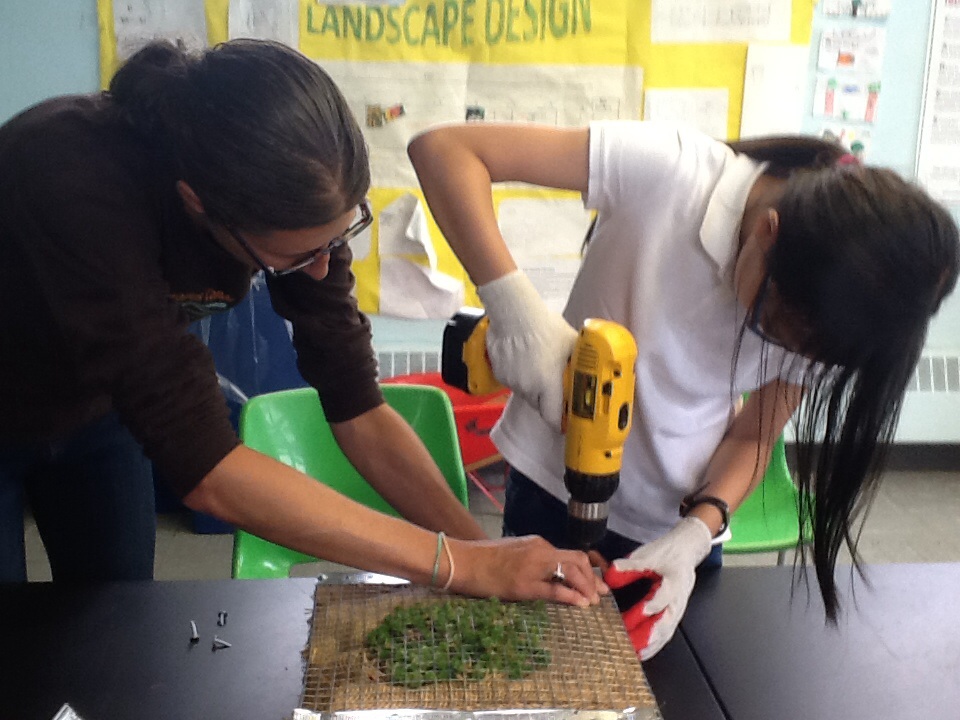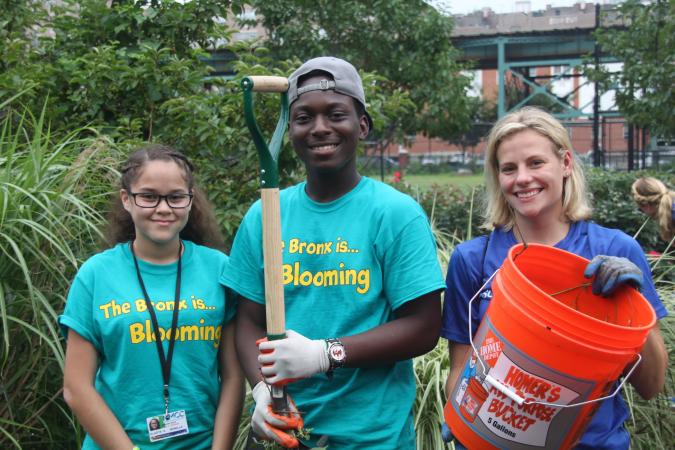Urban community gardens have been growing strong in the United States since at least the 1890s. That’s when Detroit’s then-mayor Hazen Pingree started a municipal community gardening program in the city’s vacant lots to combat an economic recession that left many industrial laborers, particularly recent immigrants, unemployed and hungry. (These plots became affectionately known as “Pingree’s Potato Patches.”) In the United Kingdom, community gardens’ European cousin, “allotment gardens,” date back even further, to the 1730s.
Hundreds of years ago, just as they still do today, community gardens offer a wide variety of benefits to those who work in, live near, or simply visit them, including:
– Improved air and soil quality
– Increased biodiversity of plants and animals
– Reduced “food miles” required to transport nutritious food
– Enhanced stormwater filtration
– Reduced food waste through composting
– Increased local access to, and intake of, fresh produce
– Improved food security
– Increased physical activity through garden maintenance and recreational activities
– Improved dietary habits through education
– Reduced risk of obesity and obesity-related diseases
– Improved mental health and relaxation
– Decreased crime rates
With all that going for them already, how are today’s community gardens blazing their own trails today? What 21st-century twists are they implementing to solve problems and benefit residents in their neighborhoods?
We’ve rounded up the following inspiring stories and how-to’s to help you grow your own successful and innovative community garden to fit your community’s unique needs, courtesy of three visionary ioby Leaders.
3 successful community gardens to get inspired by

1) Art in the Garden, Pittsburgh, PA
How they’re innovating: Led by Emily Carlson, Art in the Garden brings art projects with social justice lessons into the sensory-rich and liberating environment of an outdoor classroom: Pittsburgh’s Borland Garden. For example, Emily describes a clay workshop that asked kids, “‘When we fire a piece of pottery that we’ve made, how do we make it strong so that it can endure the fire? How do we make ourselves strong so that we can endure the struggles and challenges that we face?’ Just connecting the social, emotional piece with the artistic piece is really crucial to us.”
Why they’re doing it: “All children are at risk of facing trauma,” Emily explains. “And the effects are far-reaching: social and mental health issues, alcoholism, drug use, diabetes, depression, suicide attempts, heart disease, violence. I wanted to try to understand how to serve kids who face a lot of trauma.” Art in the Garden meshes hands-on learning with art and nature to teach children to recognize their feelings, move to a place of empowerment, and heal from trauma.
How ioby helped: For three years running, Art in the Garden has successfully funded various aspects of their programming by crowdfunding with ioby. Their latest campaign sought to raise money for an all-season shelter, so kids and teachers can still gather, work, and learn in the pouring rain or blazing sun. Emily says that, contrary to her first impressions, “Crowdfunding was actually building community for us. It was spreading the word about our project in ways that getting a grant wouldn’t have. All sorts of people felt invested and involved. It’s brought us community.”

2) BUGS Indoor Vertical Garden, Brooklyn, NY
How they’re innovating: The Brooklyn Urban Garden Charter School (BUGS) already had a student-created, school community-run food garden in its recess yard and a native plant habitat and herb garden out front. But why not bring the outside indoors, too? BUGS decided to build a series of indoor food garden systems in several locations within the school to complement its outdoor sustainability curriculum.
Why they’re doing it: BUGS’ outdoor classrooms brought value for sure, but indoor garden features would allow them more control over the plots (safe from things like weather and hungry animals), and let them garden and learn year-round, no matter the weather. Their projects included a vertical garden rack, stairwell-based vertical garden, a “tower-style” garden to move between classrooms, and garden window racks. As their ioby campaign page explained, “The garden aspect of our school’s name is sometimes a symbolic, and sometimes a literal, centerpiece of our sustainability studies.”
How ioby helped: BUGS has led numerous ioby campaigns to raise money for its initiatives. The school’s co-founder and executive director Susan Tenner says, “We’re a standalone, private nonprofit, and so having all those costs and sort of building the plane as we fly it, we really appreciated the handholding and help that the ioby team was able to give us, as a similar startup — an innovative, small, accountable, relationship-oriented group. They immediately had a can-do attitude, a real personal connection. They really supported us to get it done. The format was easy, and they let us ask all our silly questions. It was super exciting.”

3) The Bronx is Blooming, Bronx, NY
How they’re innovating: The Bronx Is Blooming is a nonprofit dedicated to environmental advocacy, community building, and youth leadership development. Its Program for Leaders Advancing their Community’s Environment (PLACE) empowers Bronx high school and college students to mentor their communities in the preservation and revitalization of local parks and gardens.
Why they’re doing it: Youth education and mentorship engender long-term stewardship and appreciation of local green spaces. PLACE addresses key health issues in the Bronx by enhancing green spaces through restoration; fighting obesity by increasing access to green spaces and encouraging physical activity; and combating asthma through the stewardship of trees in public places. Between 2013 and 2016, under the guidance of PLACE student leaders, thousands of community residents got outside and cared for their gardens and parks.
How ioby helped: The Bronx is Blooming raised over $22,000 on ioby to fund PLACE. It led other successful campaigns that raised almost $18,000 for its Community Engagement Program and over $2,000 for its Second Saturday Stipend, among others. The organization’s founder, Jennifer Beaugrand, also helped co-lead our webinar “How to Make it Rain Part 2: Crowdfunding for Nonprofits.”
Additional resources:
– Learn from a Leader: This blog and video series profiles past ioby Leaders who succeeded in bringing more fresh food, active transport, green spaces, and other healthy improvements to their neighborhoods. Starting with the link above, you can learn from resident experts about topics like, “How to bring a farmers market to your community garden,” “How to build a community garden in a public housing complex,” and “How to build a sensory garden for everyone.”
– Webinar: A great addition to our webinar series, “Bringing the Green: Crowdfunding and Community Gardens” brought community garden luminaries Sheryll Durant (of the Sustainable Flatbush Healing Herb Garden) and Avital Aboody (formerly of the H.A.C.E.R. Project’s Gilliam Family Community Space and Garden) together in conversation with ioby Leader Success Strategist Jennifer Allen to discuss the best ways to raise more green for your green space.
– Reclaim It! A Citizen’s Guide to Transforming Vacant Lots into Community Gardens: This ioby guide walks readers through the nine steps to converting a vacant lot into a community garden, how to survey potential garden sites, how to check zoning laws and water availability, how to create a budget and fundraise, and much more.
– The Land Grid: This website offers nationwide property data and mapping tools for everyone—it can be a good starting point to figure out who owns that empty lot down the street, and to see whether you and your neighbors could repurpose it for a new community garden.
– “‘Whose land is this?’ How to find out who owns vacant lots in your neighborhood”: This ioby blog post has more tips about figuring out who owns the community-garden-to-be on your block.
Feeling inspired? Want to start or upgrade a community garden where you live? There’s no time like the 21st century! Tell us your idea, and we can help you get started.